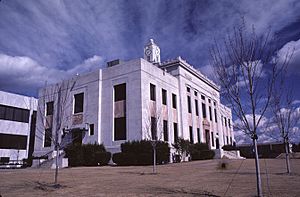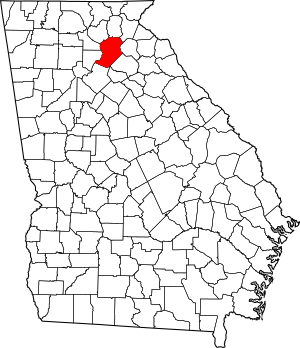Hall County, Georgia facts for kids
Quick facts for kids
Hall County
|
|||
|---|---|---|---|

Hall County courthouse in Gainesville
|
|||
|
|||

Location within the U.S. state of Georgia
|
|||
 Georgia's location within the U.S. |
|||
| Country | |||
| State | |||
| Founded | December 15, 1818 | ||
| Named for | Lyman Hall | ||
| Seat | Gainesville | ||
| Largest city | Gainesville | ||
| Area | |||
| • Total | 429 sq mi (1,110 km2) | ||
| • Land | 393 sq mi (1,020 km2) | ||
| • Water | 37 sq mi (100 km2) 8.5% | ||
| Population
(2020)
|
|||
| • Total | 203,136 |
||
| • Density | 470/sq mi (180/km2) | ||
| Time zone | UTC−5 (Eastern) | ||
| • Summer (DST) | UTC−4 (EDT) | ||
| Congressional district | 9th | ||
Hall County is a county located in the northeast part of Georgia, a state in the United States. It's a place where many people live and work.
In 2020, about 203,136 people called Hall County home. This was more than the 179,684 people who lived there in 2010. The main city and government center of the county is Gainesville. Hall County is also part of a larger group of cities, including Atlanta and Athens.
Contents
History of Hall County
Hall County was officially created on December 15, 1818. Before that, the land belonged to the Cherokee people. It became part of Georgia through agreements called the Treaty of Cherokee Agency (1817) and the Treaty of Washington (1819).
The county is named after Lyman Hall. He was a very important person in American history. Lyman Hall was one of the people who signed the Declaration of Independence. He also served as the governor of Georgia.
Geography and Nature
Hall County covers a total area of about 429 square miles. Most of this area, about 393 square miles, is land. The remaining 37 square miles (about 8.5%) is water.
The county is located in the upper Piedmont region of Georgia. This area is known for its rolling hills. To the north, you can see the beautiful foothills of the Blue Ridge Mountains.
Rivers and Waterways
Hall County is home to important rivers. The eastern part of the county is in the Upper Oconee River area. This river flows into the larger Altamaha River basin. The western part of the county is in the Upper Chattahoochee River area. This river is part of the Apalachicola-Chattahoochee-Flint River Basin.
The Chattahoochee River starts to get bigger and stronger in Hall County. A famous poet named Sidney Lanier wrote a poem about it called "Song of the Chattahoochee":
OUT of the hills of Habersham,
Down the valleys of Hall,
I hurry amain to reach the plain,
Run the rapid and leap the fall,
Split at the rock and together again,
Neighboring Counties
Hall County shares its borders with several other counties. These are:
- White County – to the north
- Habersham County – to the northeast
- Banks County – to the east
- Jackson County – to the southeast
- Barrow County – to the south
- Gwinnett County – to the southwest
- Forsyth County – to the west
- Dawson County – to the northwest
- Lumpkin County – to the northwest
Fun Places to Visit
Hall County has many exciting places to explore:
- Atlanta Botanical Garden (in Gainesville)
- Brenau Downtown Center (Gainesville)
- Don Carter State Park
- Elachee Nature Science Center (Gainesville)
- Falcons Complex (in Flowery Branch)
- Gainesville Theatre Alliance (Gainesville)
- Interactive Neighborhood for Kids (Gainesville)
- Lake Lanier Islands (in Buford)
- Lake Sidney Lanier
- Quinlan Visual Arts Center
- Road Atlanta (in Braselton)
Getting Around Hall County
Main Roads
Many important roads run through Hall County, helping people travel easily.
 Interstate 985
Interstate 985 U.S. Route 23
U.S. Route 23 U.S. Route 129
U.S. Route 129 State Route 11
State Route 11 State Route 11 Business
State Route 11 Business State Route 13
State Route 13 State Route 51
State Route 51 State Route 52
State Route 52 State Route 53
State Route 53 State Route 53 Connector
State Route 53 Connector State Route 60
State Route 60 State Route 82
State Route 82 State Route 115
State Route 115 State Route 136
State Route 136 State Route 211
State Route 211 State Route 254
State Route 254 State Route 283
State Route 283 State Route 284
State Route 284 State Route 323
State Route 323 State Route 332
State Route 332 State Route 347
State Route 347 State Route 365
State Route 365 State Route 365 Business
State Route 365 Business State Route 369
State Route 369 State Route 419 (unsigned designation for I-985)
State Route 419 (unsigned designation for I-985)
Public Transport
You can travel by train from the Gainesville AMTRAK station. The Crescent train connects Gainesville to big cities like New York City, Philadelphia, Baltimore, Washington, D.C., Atlanta, and New Orleans.
Gainesville also has its own bus system called the Gainesville Connection. It has 130 stops on three different routes. This bus system started in 2001 to help people get around the area.
Walking and Biking Paths
For those who enjoy walking or cycling, Hall County offers:
- Chicopee Woods Bike Trail
- Wilshire Trail
People of Hall County
| Historical population | |||
|---|---|---|---|
| Census | Pop. | %± | |
| 1820 | 5,086 | — | |
| 1830 | 11,748 | 131.0% | |
| 1840 | 7,875 | −33.0% | |
| 1850 | 8,713 | 10.6% | |
| 1860 | 9,366 | 7.5% | |
| 1870 | 9,607 | 2.6% | |
| 1880 | 15,298 | 59.2% | |
| 1890 | 18,047 | 18.0% | |
| 1900 | 20,752 | 15.0% | |
| 1910 | 25,730 | 24.0% | |
| 1920 | 26,822 | 4.2% | |
| 1930 | 30,313 | 13.0% | |
| 1940 | 34,822 | 14.9% | |
| 1950 | 40,113 | 15.2% | |
| 1960 | 49,739 | 24.0% | |
| 1970 | 59,405 | 19.4% | |
| 1980 | 75,649 | 27.3% | |
| 1990 | 95,428 | 26.1% | |
| 2000 | 139,277 | 45.9% | |
| 2010 | 179,684 | 29.0% | |
| 2020 | 203,136 | 13.1% | |
| 2023 (est.) | 217,267 | 20.9% | |
| U.S. Decennial Census 1790-1880 1890-1910 1920-1930 1930-1940 1940-1950 1960-1980 1980-2000 2010 2020 |
|||
Many people in Hall County live in areas that are not part of a city or town. These are called "unincorporated areas." More than half of the county's population lives in these rural parts.
Population in 2020
In 2020, the census counted 203,136 people living in Hall County. These people lived in about 65,625 households, with 48,776 of those being families.
The people in Hall County come from many different backgrounds:
| Race | Num. | Perc. |
|---|---|---|
| White (not Hispanic) | 120,418 | 59.28% |
| Black or African American (not Hispanic) | 14,256 | 7.02% |
| Native American | 341 | 0.17% |
| Asian | 4,198 | 2.07% |
| Pacific Islander | 85 | 0.04% |
| Other/mixed | 6,828 | 3.36% |
| Hispanic or Latino | 57,010 | 28.06% |
Population in 2010
Back in 2010, there were 179,684 people in Hall County. The population density was about 457.5 people per square mile.
About 74.1% of the people were white, 7.4% were Black or African American, and 1.8% were Asian. People of Hispanic or Latino background made up 26.1% of the population.
Many households (40.2%) had children under 18 living with them. The average age of people in Hall County was 34.5 years old. The average income for a family was about $57,774.
Education and Schools
Most students in Hall County attend schools in the Hall County School District. However, some parts of Buford and Gainesville have their own school districts: the Buford City School District and the Gainesville City School District.
Colleges and Universities
For students who want to continue their education after high school, Hall County has several options:
- Brenau University
- Lanier Technical College
- University of North Georgia, Gainesville Campus (used to be Gainesville State College)
High Schools
Here are the high schools in Hall County:
- Cherokee Bluff High School
- Chestatee High School
- East Hall High School
- Flowery Branch High School
- Gainesville High School
- Johnson High School
- Lakeview Academy
- North Georgia Christian School
- North Hall High School
- Riverside Military Academy
- West Hall High School
Middle Schools
Here are the middle schools in Hall County:
- Academies of Discovery at South Hall
- Alternative Learning Center/International Center
- C. W. Davis Middle School
- Cherokee Bluff Middle School
- Chestatee Middle School
- East Hall Middle School
- Gainesville Middle School
- Lanier Career Academy
- North Georgia Christian School
- North Hall Middle School
- West Hall Middle School
- World Language Middle School (shares building with South Hall)
Cities and Towns
Hall County has several cities and towns where people live.
Cities
- Buford (mostly in Gwinnett County)
- Flowery Branch
- Gainesville
- Gillsville (partly in Banks County)
- Lula (partly in Banks County)
- Oakwood
Towns
Other Communities
These are smaller communities in Hall County that are not officially cities or towns:
- Belmont
- Candler
- Chestnut Mountain
- Murrayville (partly in Lumpkin and White Counties)
- Chicopee
- Rabbittown
See also
 In Spanish: Condado de Hall (Georgia) para niños
In Spanish: Condado de Hall (Georgia) para niños



